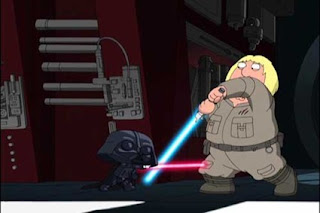Interpretation
We are in a world where change is always happening, there is always something different taking off, a new lead, a new way of doing things.
As a designer, it is so important that you are aware of everything around you.
Today, we have the power to manipulate something and change the meaning of the story to who we wish to aim it at. I am going to look at the same movie but one has a very different twist on the original and explain the reasons for the change.
I am going to discuss Star Wars. Star Wars was released in 1977 and it is without a doubt, the best science fiction film that has ever been released, I am not a huge fan of it but I am aware it has changed the way we look at films and it is a very powerful film.
This is the cliche image when you think of Star Wars. The battle. However, I am going to compare it to this.
This interpretation of Star Wars is Family Guy. A humorous take on the legendary film, straight away you can see the content has changed. For starters, it is cartoon where as the original is obviously real actors. Family Guy already have their own audience, but by doing Star Wars, it is grabbing a huge audience on top, the Star Wars geeks! They are going to want to watch this and compare it to the original. The storyline has stayed the same but the meaning has changed, it was made in a different time to the original so the take and the reaction will be different. The Family Guy take is very funny and it takes the mickey out of the original, but it is the directors interpretation on the film so it is going to reach out to a certain audience. Over time, you can see it change and the media change to get a completely different message.
Delivery
When designers design, they have to be aware on what they are designing and who it is for. This opens up to a big issue they need to resolve. What platform are they working to?
There are a number of platforms and all used in different ways;
Editorial,
Publishing,
Online,
Advertising and Branding,
Textiles/Fashion,
Installation and Interventions.
All very different platforms, so which one to use? It's simple, just decide what you are doing, is it an advertising campaign? If yes then you work on the advertising platform and so on. This would be anything from T.V ads to huge billboards all over the country. When you choose the platform, you then choose the audience.
You should be able to tell what the poster or website etc is for by looking at it.
Some designers use video and time lapse to show their work, it shows the journey they have gone through. Basically a camcorder playing in the corner and then speeded up, very simple but its very interesting t watch this piece of work taking place. Its qwerky! For example, take Blu's work. He works on very different platforms but has the same style in all of them.
Two different platforms, side of a building and a website. Two different ways of getting his work out there. But they are both the same style so you know straight away who's work it is so you can relate to it. Blu also works on video and stop start animation. He is a very determined artist and very interesting to watch his pieces take shape. This is all a way of representing yourself through platforms to show you are versatile and experimental. People like to see use of different materials, it keeps them interested and wanting to keep looking at your work.
So be experimental, be brave and take risks, all the best designers do.
On that note, Goodnight and don't let the bed bugs bite!











